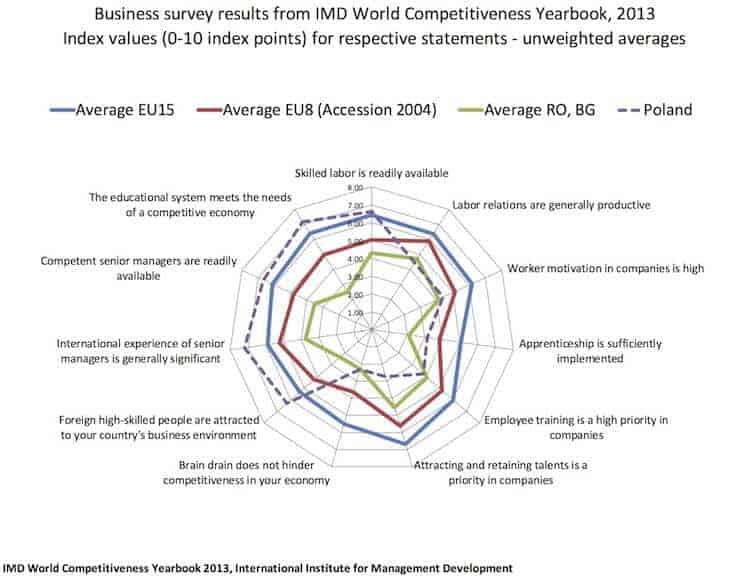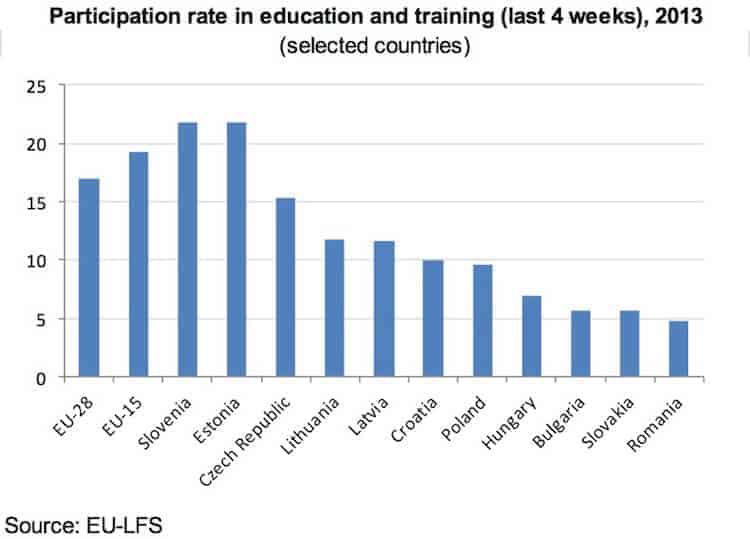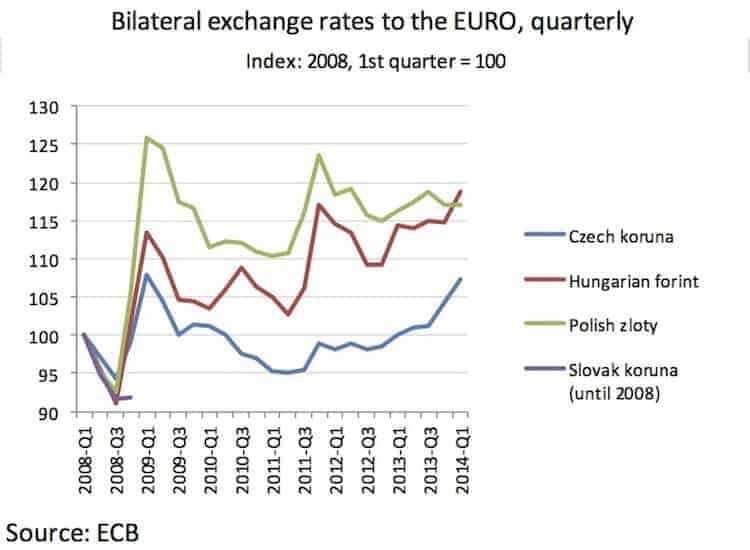
László Andor
The ‘Eastern enlargement’ in May 2004 opened the EU’s doors to ten countries. Of these, the four Visegrád states, the three Baltic countries and a former Yugoslav state had at that time completed their 15-year transition towards a market economy. In the first half of the 1990s these countries’ income, measured in terms of GDP, had fallen by 20 to 30 percent. Poland was the first country to return to the same income levels as before the transition, Hungary was next in 2000, and the other countries followed later.
The experience of the ‘great transformation’ which began in Central-Eastern Europe a quarter of a century ago played a key role in determining what the citizens of the new Member States expected from their accession to the EU: stable and sustainable growth. If we look at the decade since 2004, the region really seems to have been catching up with Western Europe in terms of both employment and economic performance.
However, the financial and economic crisis which started in 2008 disrupted the previous trend of convergence to some extent. Greater differences between individual countries’ performances also emerged. Poland and Slovakia, for example, generally continued to catch up, while Hungary fell behind on many growth, employment and social indicators.

The Community which originally (in 1957) comprised six Member States had already taken in nine additional countries prior to this enlargement. But the 2004 enlargement was different, as in this case the income disparity between new and old Member States was significant. As a result, capital flows have largely occurred from west to east in the enlarged union, while the workers go from east to west.
Although the destination countries in Western Europe benefit a great deal from mobile Central-Eastern European workers in economic terms, these countries are also witnessing a kind of “welfare chauvinism”, turning public opinion against EU migrants. Some people find it hard to accept that the EU’s enlargement to the east has brought with it not only countries and markets but also people, and that these people have the same rights. In fact, the 2004 and 2007 enlargements brought more instead of less welfare to the receiving countries: a higher proportion of mobile citizens from Central-Eastern Europe are of working age, and more often employed, compared with nationals of the destination countries, and so they are actually net contributors to their social security systems.

The real risks of labour mobility from east to west are not in the recipient countries but in the migrants’ countries of origin. A large percentage of workers who migrate from Central-Eastern Europe to the West are overqualified for the jobs in which they find themselves. In 2012 this was the case for about half of Central-Eastern European migrants who had completed higher education. This rate of over-qualification is more than twice as high as for the nationals of the receiving countries. In certain sectors of employment, particularly health care, we can speak of a ‘brain drain’ which leads to serious problems in the highly skilled workers’ countries of origin.

At the same time personal remittances paid by expatriates to their home countries have reached significant magnitudes – beyond 3% of GDP in Romania, Bulgaria and Lithuania. In the short term, these inflows are important for the prosperity and for the balance of payments of the home countries. However, in the longer term, it is questionable whether remittances can be sustained at sufficiently high levels to actually offset the negative consequences of workers’ outflow from Central-Eastern Europe and the increasing dependency ratio between the employed and non-employed population in these countries. If labour mobility is at all a threat to social security systems, it is mainly in the sending countries.

Fortunately, mobile workers also sometimes return. They bring valuable new skills and experience that benefit the economies of their countries – as shown by the example of Poland where some 130.000 people returned in 2012 according to the migration statistics, contributing to the country’s recent above-average growth performance. Generally, most people entering Central-Eastern European Member States are actually returning nationals.

The eastward enlargement which took place in 2004 and 2007 has de facto doubled the mobility of labour within the EU. This mobility is likely to be sustained as long as income disparities between Member States persist. However, this should not be seen as an automatic link that is independent of all other factors. For example, there is also a large income disparity between the Czech Republic and its neighbour Germany, and yet very few Czechs migrate. This is obviously partly due to the fact that in the Czech Republic the at-risk-of-poverty rate (10%) is even below the one in Germany (16%), despite much lower per-capita GDP.
In several of the new Member States the issue of finding a way out of poverty is linked to the situation of the Roma population. While there is also a sizeable Roma minority in some of the older Member States, for example Spain, Roma integration has really become an issue in the EU only since the 2004 enlargement. Not all Roma are poor, but in Romania, Bulgaria, Hungary, the Czech Republic and Slovakia the Roma minority and the rest of the population are a world apart in terms of education, employment, health and housing. As a result of constant prejudice and the open racism that in many cases has political support, it is difficult to overcome this disparity and often even to determine its extent.
Other features also distinguish Central-Eastern Europe from older EU Member States, for example working conditions. There are major differences between east and west with regard to the degree of organisation of employers and employees. According to the OECD, less than a fifth of wage and salary earners in Poland or the Czech Republic are actually members of trade unions – compared with a share of almost 70% in the Scandinavian Member States. This in turn means that in terms of economic policy there is a constant temptation to improve competitiveness at the expense of workers. In the area of vocational education and innovation capacity, substantial progress has only been made in Central-Eastern Europe in relation to individual foreign investments.
It can therefore be said that most of the newer Member States, irrespective of the varying speeds of convergence (in terms of GDP), have developed within the EU as an ‘inner periphery’. The region’s booming capital cities are an exception, which however only reinforces the challenge in terms of economic, social and territorial cohesion.
Eastern Enlargement -Setting Policy For The Future
In order to make better use of the potential for economic growth in Central-Eastern Europe, a first necessary step would be for the governments to rethink their role in the development of human capital and place greater emphasis on investing in it. As the coming decades must combine better living conditions for all with higher productivity growth, new investments are necessary in education, health and social inclusion, where the emphasis has up to now tended to be on cutbacks.
Greater social investment is not only a responsibility of the public sector but is also in the best interest of companies. However, survey data confirm that businesses in Central-Eastern Europe tend to attribute lower priority to human capital issues than their Western European peers. This is especially true for businesses in Romania and Bulgaria. Poland also stands out: on the one hand, Polish business seems to be more optimistic than in Western countries when it comes to the availability of skilled, educated, competent and experienced human resources. On the other hand, investments in human capital formation (apprenticeships, attracting talents, training, workers’ motivation) tend to be seen as a lower priority in Poland compared to the EU average. Such an attitude may be explained by the strength of the cohorts entering the Polish labour market in recent years, but cannot be sustained when the workforce begins to age and shrink as in the rest of Europe.

The great human capital challenge in Central-Eastern Europe is also well illustrated by data on workers’ participation in lifelong learning. With the exceptions of Slovenia and Estonia, Central-Eastern Member States tend to have a far lower percentage of workers or unemployed people who participate in training and education compared to ‘older’ Member States. According to the Labour Force Survey, in Romania, Slovakia and Bulgaria the share is only around 5%.

The necessity to step up investment in human capital should be reflected by the way Central-Eastern European countries make use of resources available from EU Structural and Investment Funds. The European Social Fund, for example, could play a much greater role than previously in helping to promote the employment of women, young professionals starting their career (by introducing the Youth Guarantee), Roma integration, labour market integration for people with disabilities and active ageing. It can also make a major contribution to improving the quality of education systems. The EU has established a rule for 2014-2020 that a certain minimum share of each country’s allocation from the Structural Funds has to be dedicated to human capital investment through the European Social Fund. However, more effective financing of these programmes depends primarily on the political will in the individual countries.
Finally, it is also worth mentioning that economic and social development programmes (where they exist) should be tailored not only to the use of EU funds but also to plans for monetary reform. The euro was successfully introduced over the past decade in four Central-Eastern European countries. Significantly, these were all among the smaller countries in the region. However, there was a price to be paid for this monetary success: in Latvia, for example, greater social inequality, and in Slovakia greater geographical inequality. Capacity for financial convergence is a virtue, but at the same time aggressive “internal devaluation”, i.e. the reduction of wages and government expenditure, which pushes up unemployment, poverty and out-migration, can undermine the potential for economic growth.
For example, over the period 2008 to 2013, Poland, Hungary and the Czech Republic have all seen their unemployment rates increase by 2 to 3 percentage points. That said, these shifts in unemployment were below EU average (+3.8 percentage points), and certainly more modest than under the ‘Baltic model’ where priority was attached to maintaining the currencies’ peg with the euro. In addition, over the same period in countries which kept their own currencies, pressure on wages had led to a noticeable decline in the real compensation per employee only in Hungary. In other words, external devaluation through the exchange rate has reduced the pressure on these countries to pursue internal devaluation. From the point of view of unemployment and wages, the crisis may have led to more detrimental labour market outcomes had these countries striven to maintain their pre-crisis exchange rate.

However, while currency devaluations reduce the pressure on labour markets during a downturn, they can hardly be seen a sustainable compensation for lacking competitiveness in the long run. Likewise, internal devaluation at the expense of the economy’s human capital is socially unacceptable and represents an equally poor substitute for reforms and investments that genuinely strengthen productivity and competitiveness. The point is again that Central-European countries need to invest in human capital in order to be able to reap the benefits of joining the euro zone. However, the problem of economic adjustment within the monetary union is European by nature, so that satisfactory answers must be found at the European level: Member States confronted with economic shocks should not be left alone and condemned to internal devaluation in an effort to restore growth.
The major question for the second decade of our enlarged Union – aside from the reform of the monetary union – is whether the EU’s eastern region can continue to catch up without the internal socio-economic polarisation observed thus far, and whether the latter process can in fact be reversed. Whether EU membership has been positive for the new Member States is something that cannot be measured only in terms of gross domestic product. The quality of economic development and the changes in society are at least as important, if not more important.
If the ‘new Member States’ wish to create a new development path for themselves that has the qualities of being smart, sustainable and inclusive, they must promote stronger (and genuine) social dialogue. If Europe moves towards a more successful, globally competitive “balance of interests” model of economy and society, this may bring significant benefits for Central-Eastern Europe. This is the aim of the EU’s policy recommendations. The question is whether the necessary social and political will exists on the ground.
This text is an adapted version of an article published recently in the Hungarian daily newspaper Népszabadság. Click here to open a PDF document with more data.
László Andor is secretary general of the Foundation for European Progressive Studies and a former member of the European Commission.
